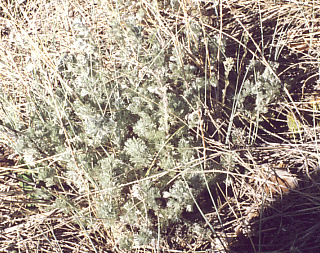English
sagebrush
Scientific Name
Artemisia spp
Arapaho
nóókoosé’Translation of the Arapaho
‘white bush’
Sagebrush and the Arapaho
Drug: analgesic. Toll 1914 reports that this plant was “snuffed” for
headaches.
Drug: digestive aid. A tea is drunk for indigestion.
Drug: hemostat and/or anti-hemorrhagic. An elder today reports that sagebrush
is rubbed, then breathed up the nose to stop nosebleeds. Alternately, part
of the plant can be stuck in the nose. Murphey 1959 reports this use as well.
Drug: respiratory aid: It is reported by one elder to be boiled and used for
asthma and colds. This is perhaps by means of an herbal steam bath.
Drug: dermatological aid: An elder reports that after being boiled (as a decoction?),
it
is used externally on sores.
Dye: green (Murphey 1959).
Other: good luck charm. Many people carry sagebrush for luck and protection,
such as on trips, or in their purse or wallet. Sagebrush was also placed in
pillows, to avoid seeings ghosts as one slept at night, including by men working
on the Arapaho Ranch (which is notorious for thost sightings).
Other: ceremonial item. Sagebrush is used by the Arapaho for smudging and for
making a tea. It is widely used today ceremonially (the Sun Dance, for example).
Kroeber reports the same practice in the Crazy Lodge ceremony (1983:193).
Murphey confirms the identity of Artemisia frigida in particular,
and reports uses of the leaves for a green dye, as well as medicinally for
hemorrhages, and general ceremonial use. Hilger however says that
sage was not used “in making decoctions or fumes.” Artemisia ludoviciana
was identified in the field by the author, and it is the preferred plant for
ceremonial uses according to elders at that time.

Artemisia ludoviciana

Artemisa frigida